Anesthetics work by interacting with your cell membranes and specific protein channels, mainly sodium channels, to block nerve signals and disrupt brain activity. They usually contain an aromatic ring for lipid solubility and a chain that influences their stability and metabolism. This interaction alters membrane fluidity and ion channel function, leading to reversible loss of sensation and consciousness. To understand exactly how these structural features cause anesthesia, keep exploring this fascinating chemistry.
Key Takeaways
- Anesthetics are amphiphilic molecules that insert into cell membranes, altering their fluidity and ion channel function to induce loss of consciousness.
- They primarily block voltage-gated sodium channels, preventing nerve impulse transmission and producing anesthesia.
- Structural features like aromatic rings and chain types (ester or amide) influence their potency, metabolism, and duration.
- Lipid solubility enhances membrane penetration and anesthetic potency but also affects systemic toxicity.
- Tissue pH and fiber type determine anesthetic effectiveness, with inflamed or acidic tissues hindering drug action.
The Diverse Chemical Classes of Anesthetics
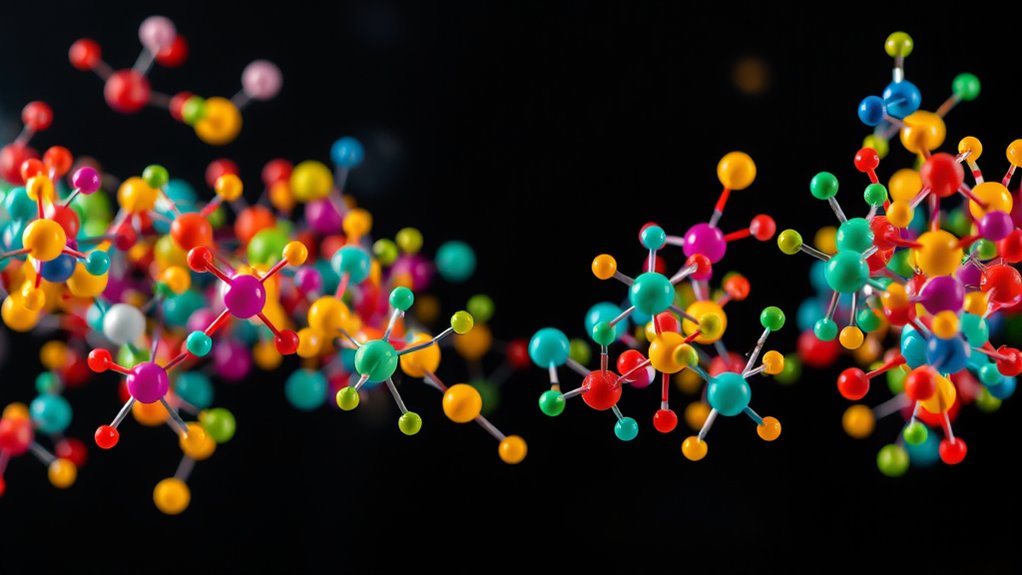
Anesthetics are classified into different chemical groups based on their molecular structure, which influences their pharmacological properties and clinical use. You’ll find two main categories: amino esters and amino amides.
Esters, like procaine and tetracaine, contain an –COO– linkage and are less stable in solution, leading to shorter durations. Amides, such as lidocaine and bupivacaine, have an –NH–CO– bond, making them more stable and primarily metabolized in the liver. This structural difference also affects their potential for allergic reactions, with esters being more allergenic. Naturally derived agents like cocaine are esters with unique properties, including vasoconstriction. These chemical structures affect how the drugs are processed in your body, their potential for allergies, and their potency.
Understanding these classes helps explain why different anesthetics are suited for specific clinical situations.
How Anesthetics Interact With Cell Membranes
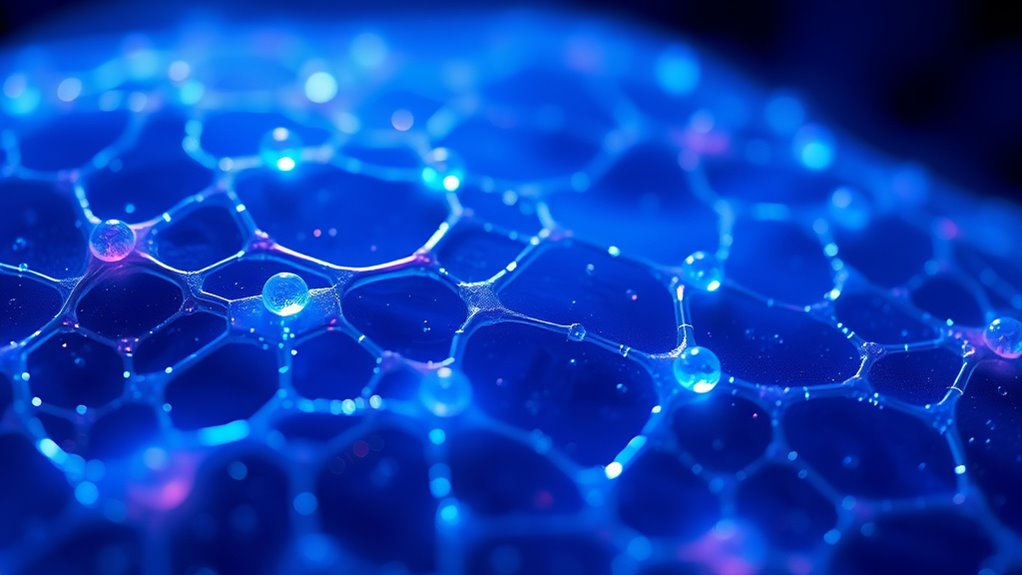
Because of their amphiphilic nature, local anesthetics can readily insert into cell membranes by combining their hydrophobic aromatic rings with the lipid bilayer’s hydrocarbon regions, while their hydrophilic amino groups position near the membrane’s polar interface. This insertion modifies the membrane’s physical properties, such as fluidity, microviscosity, and packing, without necessarily changing bulk lipid structure at clinical doses.
These interactions influence membrane protein function by altering electrostatic potential and causing conformational changes in ion channels, especially voltage-gated sodium channels. Anesthetics can also bind directly within channel proteins, enhancing their effects.
Their affinity for membranes affects pharmacological potency and side effects, including cardiotoxicity. Overall, anesthetic-membrane interactions are fundamental to their ability to disrupt nerve signaling and induce anesthesia.
Membrane Changes and Their Role in Anesthesia

Membrane changes play a crucial role in the way anesthesia works by directly affecting the physical and functional properties of nerve cell membranes. Anesthetics fluidize membranes, disrupting lipid phase separations, which alters protein conformation and ion channel activity. They also interfere with lipid rafts, impacting membrane-bound enzymes and potassium channels. These changes influence ion gating and synaptic activity, impairing neurotransmitter release and neural communication. Anesthetics may hyperpolarize membranes and modify resting potentials, further dampening nerve signals. Recent research highlights how anesthetics target specific membrane lipids, activating ion channels through lipid interactions. The influence of membrane composition on anesthetic potency underscores the importance of membrane fluidity in anesthesia mechanisms. These membrane alterations contribute to the loss of consciousness and neural suppression, supporting theories that anesthesia’s primary mechanism involves disrupting membrane integrity and function rather than solely targeting proteins.
The Pharmacology of Local Anesthetics and Nerve Blockade

Local anesthetics produce nerve blockade primarily by targeting voltage-gated sodium channels, preventing the initiation and propagation of action potentials. They bind to the α subunit of these channels, blocking sodium influx into neurons.
While they also interact with potassium and calcium channels, sodium channels are their main target. This inhibition stops nerve signals from passing, providing localized pain relief.
The blockade is reversible; once the anesthetic is metabolized or removed, nerve function resumes. Their effect is specific to the injection site, minimizing systemic side effects.
Structurally, they consist of a lipophilic aromatic group, an intermediate ester or amide chain, and a hydrophilic amine group. Increased lipid solubility generally enhances potency and duration, making them effective for various medical procedures requiring targeted anesthesia.
Structural Features That Make an Effective Anesthetic
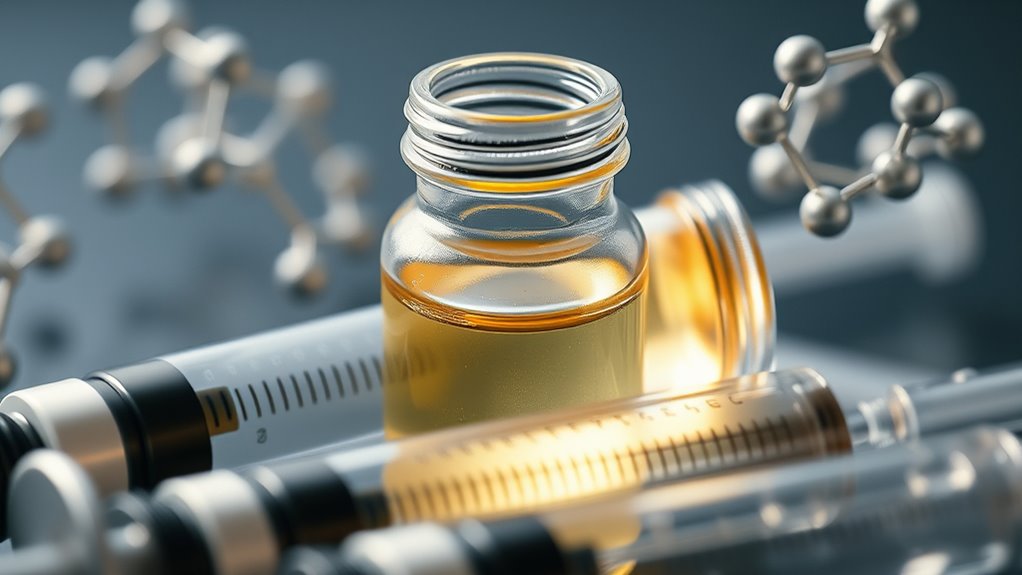
The effectiveness of an anesthetic largely depends on its molecular structure, which determines how it interacts with nerve tissues and ion channels. You’ll notice a three-part structure: a lipophilic aromatic ring, an intermediate ester or amide chain, and a terminal amine. The aromatic ring boosts lipid solubility, helping the molecule penetrate nerve membranes. The chain influences how the drug is metabolized—esters break down quickly, while amides last longer. The terminal amine exists as uncharged or charged; the uncharged form crosses membranes easily, while the charged form blocks sodium channels inside the neuron. This charge-dependent behavior is vital for blocking nerve signals effectively. Understanding these structural components is crucial for designing new anesthetics that are both effective and safe. These structural features work together, ensuring the anesthetic reaches its target and provides reliable anesthesia. Additionally, the balance between the uncharged and charged forms affects the drug’s onset and duration of action, highlighting the importance of molecular properties in anesthetic efficacy.
The Evolution of Anesthetic Chemistry Through the Ages
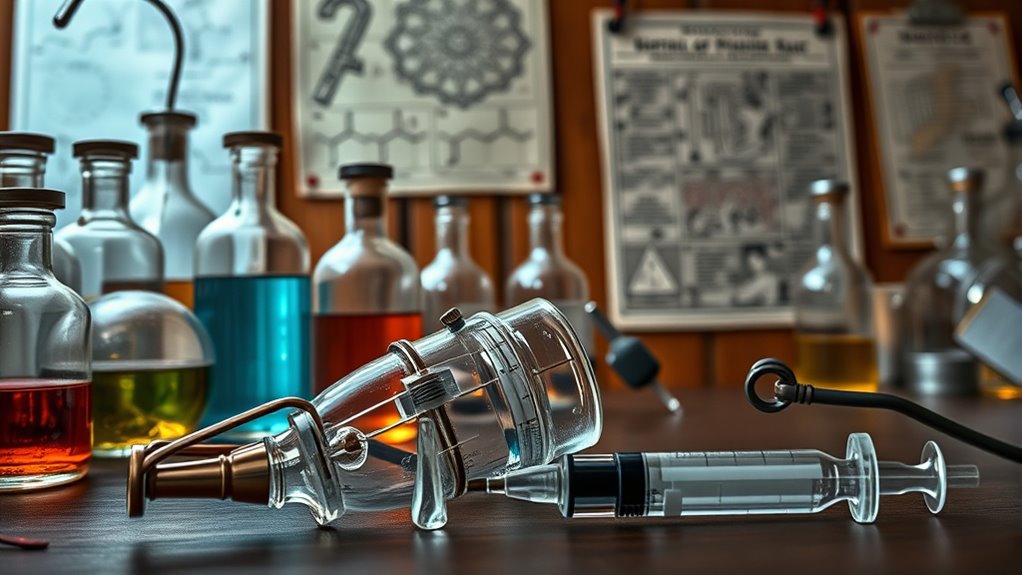
Ancient civilizations relied on natural substances like opium, herbal mixtures, and fermented drinks to induce sedation and relieve pain. The opium poppy, used as early as 4000 BCE, provided powerful analgesic effects, while herbal mixtures from plants like henbane and mandrake offered sedative properties. Ethanol combined with herbs was also common for calming effects. Self Watering Plant Pots have become popular modern gardening tools, though they are unrelated to anesthetic chemistry.
Chinese physician Hua Tuo developed “mafeisan,” a herbal anesthetic using hemp and wine, and Paracelsus experimented with opium recipes.
Over time, modern anesthetic chemistry advanced rapidly, with nitrous oxide in 1844, ether in 1842, and chloroform in 1847 revolutionizing surgery. Innovations like anesthetic machines, inhalation agents, and local anesthetics emerged, transforming anesthesia into a specialized field based on safer, more effective chemical agents.
Clinical Uses and Characteristics of Different Anesthetics

Different types of anesthetics serve distinct clinical purposes based on their specific characteristics. General anesthesia causes complete unconsciousness, making it ideal for major surgeries like open-heart procedures or knee replacements. You receive it intravenously or through inhaled gases, providing rapid induction and pain relief. Because it affects cardiovascular and respiratory systems, you need continuous monitoring and support. Ethical hacking principles are sometimes applied in the development of safer anesthetic protocols to ensure patient safety. Regional anesthesia numb large body areas, such as during childbirth or limb surgeries, while you stay awake. It offers localized pain relief with less systemic impact and faster recovery. Local anesthesia is perfect for minor procedures like mole removal, numbing small areas without affecting consciousness. Sedation and monitored anesthesia care provide varying levels of consciousness, helping you stay comfortable during minimally invasive procedures.
Factors Influencing the Effectiveness of Anesthetic Agents
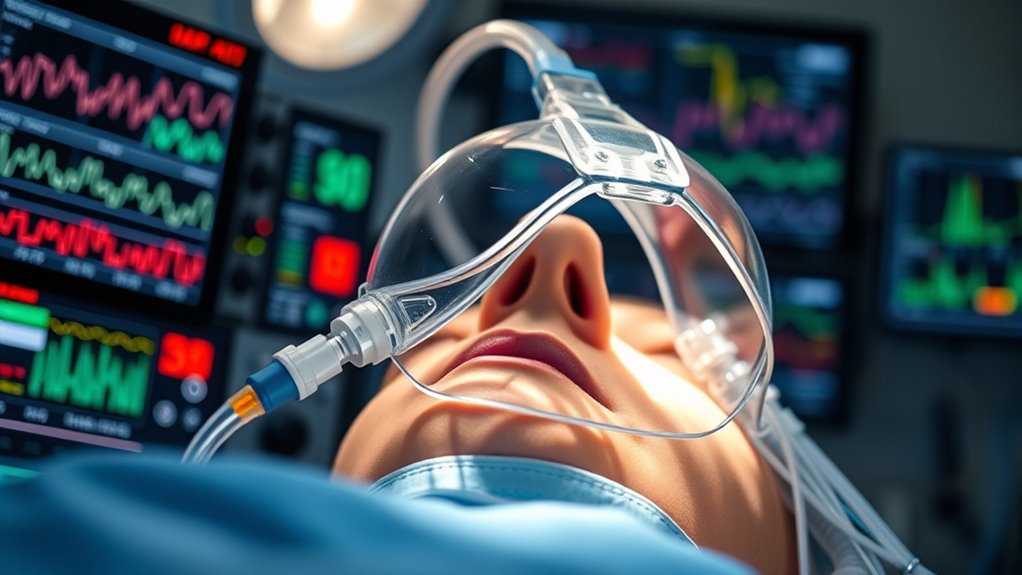
Various factors influence how effective an anesthetic agent will be during a procedure. pH and tissue environment play a significant role; inflamed, acidic tissues reduce anesthetic penetration because ionized molecules can’t cross nerve membranes easily. Adjusting the pH or avoiding acidic areas helps improve effectiveness. Lipid solubility and protein binding also matter: more lipid-soluble agents cross nerves faster, and higher protein binding prolongs effects. Diffusibility affects how quickly anesthesia starts; warmer tissues and additives like vasoconstrictors can speed onset. Vasodilators increase blood flow, shortening duration, while vasoconstrictors extend it. Nerve fiber susceptibility varies—smaller, unmyelinated fibers are blocked more easily. The table summarizes these influences:
| Factor | Impact |
|---|---|
| Tissue pH | Acidic reduces effectiveness |
| Lipid Solubility | Higher increases potency and toxicity |
| Vasoconstrictors | Prolong duration, reduce systemic absorption |
Additionally, understanding the tissue environment helps clinicians optimize anesthesia efficacy and safety.
Frequently Asked Questions
How Do Anesthetics Selectively Target Nerve Cells Without Harming Others?
You might wonder how anesthetics target nerve cells specifically without damaging other cells. They do this by binding selectively to ion channels and receptors abundant in neurons involved in consciousness and pain pathways.
Their chemical structures allow them to fit into hydrophobic pockets unique to nerve cell proteins. This selective binding disrupts neural communication, suppressing consciousness while sparing non-neuronal cells, ensuring safety and effectiveness during anesthesia.
Why Do Some Anesthetics Cause Allergic Reactions While Others Do Not?
You’re wondering why some anesthetics cause allergic reactions while others don’t. Allergic responses happen when your immune system overreacts to specific drug components, like proteins or additives.
Certain drugs, such as neuromuscular blockers with quaternary ammonium groups, are more allergenic. Your history of allergies, previous exposures, and sensitivities influence this risk.
To minimize reactions, medical teams screen for allergies and choose agents carefully, ensuring your safety during anesthesia.
Can Structural Modifications Improve Anesthetic Safety and Efficacy?
Did you know that structural modifications can markedly enhance anesthetic safety and efficacy? By tweaking molecular structures, you can reduce side effects, improve receptor targeting, and control drug duration.
These changes help create anesthetics with better pharmacokinetics, lowering toxicity risks and ensuring smoother recoveries. So, yes, strategic structural tweaks are essential for developing safer, more effective anesthetic drugs tailored to individual needs.
How Does Pressure Reverse Anesthetic Effects at the Molecular Level?
You might wonder how pressure reverses anesthesia on a molecular level. When pressure increases, it reduces the solubility of anesthetic molecules in lipid membranes, displacing them from their target sites.
This stabilizes the membrane structure, counteracting the fluidizing effect of anesthetics. As a result, ion channels and receptors return to their normal function, weakening the anesthetic effect and helping you regain sensation and consciousness.
Are There Differences in How General and Local Anesthetics Work Chemically?
You wonder if general and local anesthetics differ chemically in how they work. They do—general anesthetics are often weakly polar, affecting membrane properties and enhancing inhibitory receptors.
Meanwhile, local anesthetics are more lipophilic, mainly blocking sodium channels directly.
You’ll find that their delivery methods, effects, and structures vary, reflecting their distinct roles in anesthesia.
These chemical differences help tailor their specific applications and safety profiles.
Conclusion
Understanding the chemistry of anesthetics reveals how they gently lull your body into unconsciousness, like a master key opening your mind’s door. From their diverse structures to their interaction with cell membranes, each element plays an essential role in ensuring safe and effective anesthesia. By grasping these scientific secrets, you can appreciate how these tiny molecules orchestrate a seamless symphony—bringing safety, comfort, and peace during your most vulnerable moments.









